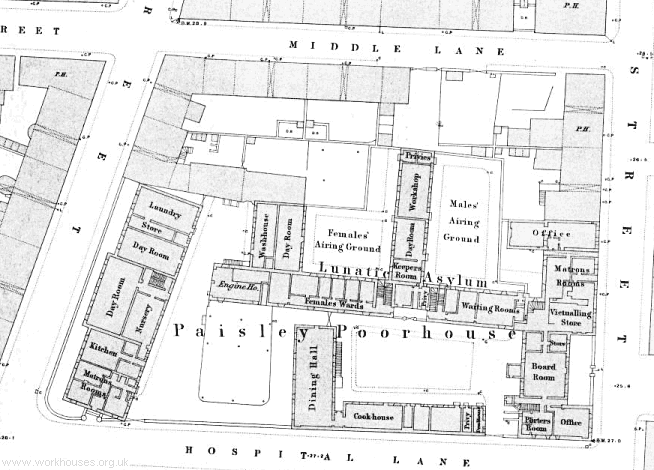Paisley, Renfrewshire
In May, 1752, the Parish of Paisley opened a Burgh poorhouse at the west side of Sneddon Street, between Middle Lane and Hospital Lane. The town council and all the local trade societies contributed to its cost. A lunatic asylum was also incorporated into the site. The poorhouse location and layout are shown on the 1858 map below.

Paisley workhouse site, 1858.
In 1856, a Visiting Officer from the Board of Supervision raised concern about certain aspects of the accommodation at the poorhouse. The male and female airing yards were inadequately separated, and access to the kitchens was only through the male yard. The dormitories were also too small and it was long-standing practice for adult males to sleep two to a bed although "all males who are not of cleanly habits, all such as wish to sleep alone are accommodated with single beds". In 1867, a further inspection advised that an Itch ward was required. In 1874, it was suggested that chamber pots be used to replace the "present wooden utensils". Also, the eggs of "vermin" (lice) were found in considerable numbers in the heads of girl inmates.
From 1895, Paisley's Abbey poorhouse took on the role for the whole of the town and became known as the Paisley Poorhouse.
In 1907, the Board of Supervision published extracts from the previous year's annual report by the poorhouse's governor, Hugh Black:
At the end of the year [1905] there were chargeable in the Poorhouse 30 boys and 26 girls, a total of 56 children. All the children of school age are sent to schools outside the Poorhouse; those of the Protestant persuasion to the South Public School, and those of the R.C. persuasion to St. Charles' R.C. School; both schools being within five minutes' walk from the Poorhouse. The religious instruction of the Protestant children is attended to by the chaplain of the institution, who gives them lessons every Saturday forenoon. They also attend the religious services held in the dining-hall every Sabbath day at 11 a.m. and 5 p.m. The R.C. children are allowed out to services held in chapel on Sabbath forenoon.
The girls are taught house-cleaning and darning and mending of clothes; and all children are taught how to use knives and forks. They are in charge of a paid official. In the last report by the visiting officer of the Local Government Board it is stated "they were well looked after."
The system of boarding children in the country has long been in vogue in Paisley parish, and has met with great success. It is a rare occasion for a child to be brought back to the Poorhouse after being boarded. Mr. Campbell, the Inspector of Poor, visits periodically at the Poorhouse, and examines the children chargeable as to their suitability for being boarded out; and during the past year 28 children were discharged and sent to the country. Those remaining in the Poorhouse at the end of the year were either unfit to be boarded on account of sickness or were temporarily chargeable with their parents
In 1906, the inmates were provided with an automatic hand-loom weaving machine, with which it was intended to weave materials for use in the Institution. In the same year, a 4.5-acre piece of ground at the back of the laundry buildings was laid out as a vegetable garden. This provided work for a number of the inmates and also a plentiful and varied supply of vegetables for consumption in the Institution.
Children's Homes
In 1910, the Paisley Parish Council took over a large property known as Auchentorlie House on Seedhill Road to the east of Paisley. The house was used as a children's home and for maternity cases and had a total capacity of 77 inmates. The buildings consisted of two floors, plus attics, and included dormitories for boys and girls, a day room and dining-hall for the children, a waiting room for maternity cases, an accouchement (delivery) room, probationary wards, bathrooms and lavatories, kitchens and outhouses, and staff quarters. The children's home was intended for to prevent children of good character from coming into contact with the ordinary inmates of the poorhouse. Modern housing now stands on the Auchentorlie House site.
From about 1910, neglected and under-fed children were sent to a separate children's home known as Arbinafield, on Douglas Place, Largs, with places for 30 children. The home appears to have closed in about 1920.
In about 1916, a second home at Largs was opened at Barrholm, 31 Moorburn Road, and accommodated 35 children. It continued in use until 1983 then became a nursing home.
Staff
Inmates
Records
Note: many repositories impose a closure period of up to 100 years for records identifying individuals. Before travelling a long distance, always check that the records you want to consult will be available.
- Heritage Centre, Paisley Central Library, High Street, Paisley PA1 2BA. Most poor law records are surname indexed. A consolidated index to all the names in these records is now available at: libcat.renfrewshire.gov.uk/iguana/www.main.cls?surl=PoorLaw
Bibliography
- Government and Social Conditions in Scotland 1845-1919 by Ian Levitt (1988, Scottish History Society)
Links
- None.
Unless otherwise indicated, this page () is copyright Peter Higginbotham. Contents may not be reproduced without permission.


